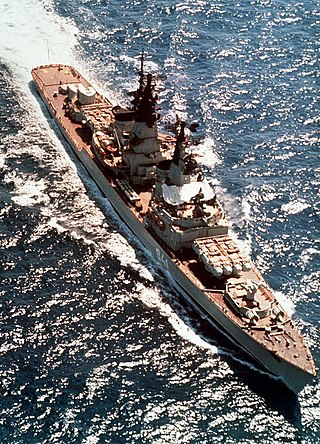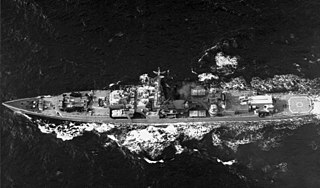Operators
 Russia
Russia
| SS-N-29 | |
|---|---|
| Type | Anti-submarine missile |
| Service history | |
| Used by | Russia |
| Production history | |
| Designer | Moscow Institute of Thermal Technology |
| Specifications | |
| Mass | Whole system: 19.4 t Missile: 800 kg (1,800 lb) |
| Length | 5.53 m (18.1 ft) |
| Diameter | 400 mm (16 in) |
| Warhead | MPT-1UE-Torpedo |
Operational range | 20 km (12 mi) |
RPK-9 Medvedka ("Mole cricket", NATO Designation SS-N-29) [1] [2] is a modern missile system used to engage submarines. The system consists of a launcher with eight missiles, each with the small torpedo as the warhead.

Project 651, known in the West by its NATO reporting name Juliett class, was a class of Soviet diesel-electric submarines armed with cruise missiles. They were designed in the late 1950s to provide the Soviet Navy with a nuclear strike capability against targets along the east coast of the United States and enemy combatants. The head of the design team was Abram Samuilovich Kassatsier. They carried four nuclear-capable cruise missiles with a range of approximately 300 nautical miles (560 km), which could be launched while the submarine was surfaced and moving less than four knots (7.4 km/h). Once surfaced, the first missile could be launched in about five minutes; subsequent missiles would follow within about ten seconds each. Initially, the missiles were the inertially-guided P-5. When submarine-launched ballistic missiles rendered the P-5s obsolescent, they were replaced with the P-6 designed to attack aircraft carriers. A special 10 m2 target guidance radar was built into the forward edge of the sail structure, which opened by rotating. One boat was eventually fitted with the Kasatka satellite downlink for targeting information to support P-500 4K-80 "Bazalt" anti-ship cruise missiles. The Juliett class had a low magnetic signature austenitic steel double hull, covered by two inches (51 mm) thick black tiles made of sound-absorbing hard rubber.

The Santa María class of guided missile frigates is the Spanish Navy's designation for six warships based on the United States Oliver Hazard Perry-class frigates. Spanish ships have a slightly bigger beam and were built with a greater weight reserve for future improvements. Other changes from the basic model include Meroka replacing Phalanx and a RAN-12L air search radar to provide low horizon coverage against sea skimmers cueing the Meroka CIWS mount. The Nettunel EW suite replaced the SLQ-32 system fitted aboard US ships. The first ship Santa Maria entered service in 1986.

Santa María (F81) is the lead ship of six Spanish-built Santa Maria-class frigates of the Spanish Navy, based on the American Oliver Hazard Perry class design. The vessel was constructed in 1982 and was launched on 11 November 1984. Santa María was commissioned on 12 October 1986. The frigate has served in NATO maritime operations.

The Udaloy class, Soviet designation Project 1155 Fregat and Russian designation Project 11551 Fregat-M, are series of anti-submarine guided-missile destroyers built for the Soviet Navy, seven of which are currently in service with the Russian Navy. Twelve ships were built between 1980 and 1990, while the thirteenth ship built to a modified design, known as Udaloy II class, followed in 1999. They complement the Sovremenny-class destroyers in anti-aircraft and anti-surface warfare operations. The codename Udaloy comes from an Russian adjective удалой, meaning daring or bold.

Metel Anti-Ship Complex is a Russian family of anti-submarine missiles. There are different anti-submarine variants ('Metel') for cruisers and frigates, and a later version with a shaped charge ('Rastrub') that can be used against shipping as well as submarines.

An anti-submarine missile is a standoff anti-submarine weapon. Often a variant of anti-ship missile designs, an anti-submarine systems typically use a jet or rocket engine, to deliver an explosive warhead aimed directly at a submarine, a depth charge, or a homing torpedo that is carried from a launch ship, or other platform, to the vicinity of a target.
K-64 was the lead ship of the Project 705 nuclear-powered attack submarines of the Soviet Navy.

Varyag was the fourth and final ship of the Soviet Navy Project 58 Groznyy-class Guided Missile Cruisers, also known as the Kynda Class.

The Sovremenny class, Soviet designation Project 956 Sarych (buzzard), is a class of anti-ship and anti-aircraft guided-missile destroyers of the Soviet and later Russian Navy. The ships are named after qualities, with "Sovremenny" translating as "modern" or "contemporary". Most of the ships have been retired from active service and one converted into a museum ship in 2018; as of 2021 three remain in commission with the Russian Navy with several in overhaul. Four modified ships were delivered to the People's Liberation Army Navy, and remain in service.

Zadornyy was a Project 1135 Burevestnik-class guard ship or Krivak-class frigate that served with the Soviet and Russian Navies. Displacing 3,200 tonnes full load, the vessel was built around the Metel anti-submarine missile system. Zadornyy was launched on 25 March 1979 in Leningrad, the last of the class to be built by the A.A. Zhdanov shipyard, and served with the Northern Fleet. After taking part in exercises Avangard-81, Sever-81 and Okean-83, and cruising as far as Havana, Cuba, the vessel was upgraded between 11 June 1990 and 23 May 1995 with missiles that added anti-ship capability. While serving with the Russian Navy, the ship took part in joint exercises with frigates of the Royal Navy, including a commemoration of the first Arctic convoy of the Second World War with HMS Campbeltown. After more than twenty-five years service, the ship was decommissioned on 3 December 2005.

Deyatelnyy was a Soviet Navy 1135 Burevestnik-class Large Anti-Submarine Ship or Krivak-class frigate. Displacing 3,200 tonnes full load, the vessel was built around the Metel anti-submarine missile system. Launched on 6 April 1975, Deyatelnyy served with the Black Sea Fleet and, as well as Bulgaria in the Black Sea, spent the next two decades travelling as far as the Mediterranean Sea to visit ports in North Africa for cultural reasons and to improve relations between the Soviet Union and other nations, For example, in 1981, the ship was the first Soviet vessel for more than ten years to visit Libya. In 1987, the vessel was used to test a new missile for the Metel system that added anti-ship capability. The ship was taken out of service for repair and modernisation in 1991. However, lack of funding meant that, instead, Deyatelnyy was decommissioned on 10 June 1995 and broken up.

Dostoynyy was a Project 1135 Burevestnik-class Large Anti-Submarine Ship or Krivak-class frigate. With an armament based around the Metel anti-submarine missile system, the vessel was commissioned on 31 December 1971 into the Northern Fleet of the Soviet Navy. The vessel took part in a number of exercises, including Okean-75, Sever-77 and Eskadra-84 and as far away as the Mediterranean Sea as part of the Soviet demonstration of their Naval reach. The ship was designated a Guard Ship from 28 July 1977 in response to a change in emphasis of the navy, and was upgraded between January 1985 and August 1988 with missiles that added anti-ship capability. After more than twenty years service, the ship was decommissioned on 30 June 1993.

Groznyy was the lead ship of the Soviet Navy Project 58 Groznyy-class guided missile cruisers, also known as the Kynda class. Originally designated a destroyer, the vessel was reclassified as a cruiser on 29 September 1962.

Admiral Fokin was the second ship of the Soviet Navy Project 58 Groznyy-class Guided Missile Cruisers, also known as the Kynda Class. Launched on 19 November 1961, the vessel served with the Russian Pacific Fleet from the latter half of the 1960s through the 1980s. It undertook a tour of the Indian Ocean, which included visits to foreign ports. Admiral Fokin was transferred to the Russian Navy after the dissolution of the Soviet Union, but was decommissioned on 30 June 1993 and scrapped.

Admiral Golovko was the third ship of the Soviet Navy Project 58 Groznyy-class Guided Missile Cruisers, also known as the Kynda Class.

Admiral Zozulya was the lead ship of the Soviet Navy Project 1134 Admiral Zozulya-class Large Anti-submarine Ship also known as the Kresta I Class guided missile cruisers. Launched in 1965, the ship was reclassified a Large Rocket Ship in 1977. Admiral Zozulya served primarily in the Northern Fleet during the Cold War, transferring to the Russian Navy at the dissolution of the Soviet Navy, and was decommissioned in 1994 after nearly thirty years of service.

Doblestnyy was a Project 1135 Burevestnik-class Large Anti-Submarine Ship or Krivak-class frigate. With an armament centred on four Metel missiles, the ship was launched on 22 February 1973 and joined the Northern Fleet of the Soviet Navy as a dedicated anti-submarine vessel. Doblestnyy was designated a Guard Ship from 28 July 1977 in response to a change in emphasis of the navy, and subsequently undertook visits to a number of African nations, including Angola and Ghana. Taken out of service to be repaired and upgraded on 19 June 1991, a lack of funding meant that this was cancelled and instead the vessel was decommissioned. The vessel was sold to be broken up on 18 July 1995.

Svirepyy was a Project 1135 Burevestnik-class Large Anti-Submarine Ship or Krivak-class frigate that served with the Soviet Navy. Displacing 3,200 tonnes full load, the vessel was built around the Metel anti-submarine missile system. The ship was launched on 27 January 1971 in Kaliningrad and joined the Baltic Fleet. The ship's service was not restricted to the Baltic Sea and instead travelled widely, visiting a number of foreign friendly ports during the next two decades, including Gdynia, Poland and Havana, Cuba. Svirepyy was designated a Guard Ship from 1977 as Soviet strategy changed to one creating safe areas for friendly submarines close to the coast. However, the ship continued to travel widely, including trips to the capital cities of both Finland and Tunisia as well as Rostock in East Germany. Svirepyy was transferred to the Russian Navy after the dissolution of the Soviet Union, but did not last long before being decommissioned on 30 June 1993 and subsequently broken up.

Razyashchiy was a Project 1135 Burevestnik-class Large Anti-Submarine Ship or Krivak-class frigate of the Soviet Navy. Displacing 3,200 tonnes full load, the vessel was built around the Metel anti-submarine missile system. Launched on 22 July 1974, Razyashchiy joined the Pacific Fleet of the Soviet Navy. While serving in the Arabian Sea, in 1983, Razyashchiy suffered minor hull damage from colliding with the destroyer USS Fife while approaching a US fleet. The ship also undertook visits to Port Louis, Mauritius, and Danang, Vietnam, to, among other objectives, enhance the relationships between these countries and the Soviet Union. In 1991, the vessel was transferred to the newly-formed Russian Navy. After nearly twenty years of service, however, Razyashchiy was in a poor state and so was decommissioned on 29 October 1992 and sold to be broken up on 6 October 1994.